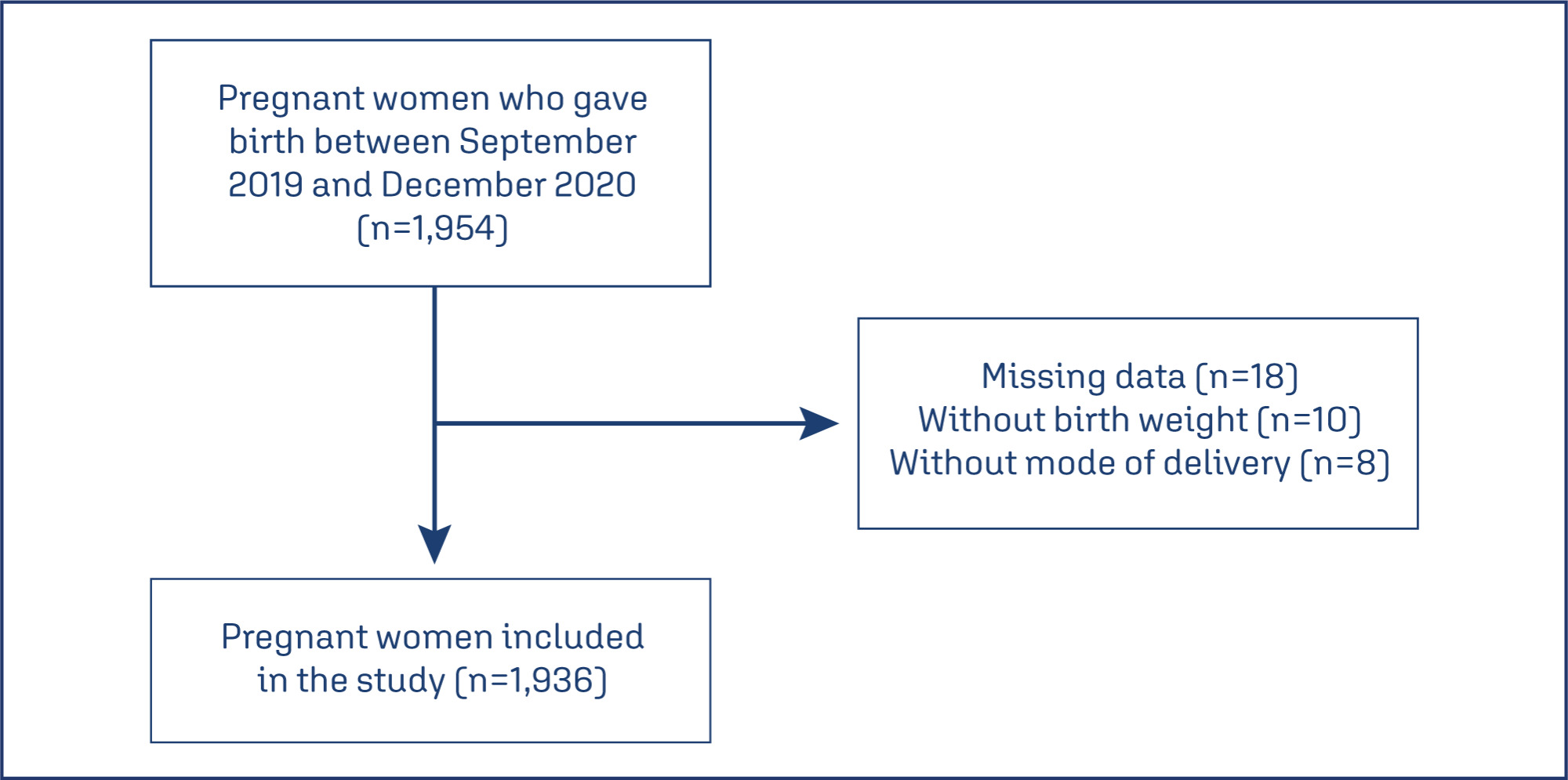Summary
Rev Bras Ginecol Obstet. 2024;46:e-rbgo14
Postpartum hemorrhage (PPH) is the leading cause of maternal death globally. Therefore, prevention strategies have been created. The study aimed to evaluate the occurrence of PPH and its risk factors after implementing a risk stratification at admission in a teaching hospital.
A retrospective cohort involving a database of SISMATER® electronic medical record. Classification in low, medium, or high risk for PPH was performed through data filled out by the obstetrician-assistant. PPH frequency was calculated, compared among these groups and associated with the risk factors.
The prevalence of PPH was 6.8%, 131 among 1,936 women. Sixty-eight (51.9%) of them occurred in the high-risk group, 30 (22.9%) in the medium-risk and 33 (25.2%) in the low-risk group. The adjusted-odds ratio (OR) for PPH were analyzed using a confidence interval (95% CI) and was significantly higher in who presented multiple pregnancy (OR 2.88, 95% CI 1.28 to 6.49), active bleeding on admission (OR 6.12, 95% CI 1.20 to 4.65), non-cephalic presentation (OR 2.36, 95% CI 1.20 to 4.65), retained placenta (OR 9.39, 95% CI 2.90 to 30.46) and placental abruption (OR 6.95, 95% CI 2.06 to 23.48). Vaginal delivery figured out as a protective factor (OR 0.58, 95% CI 0.34 to 0.98).
Prediction of PPH is still a challenge since its unpredictable factor arrangements. The fact that the analysis did not demonstrate a relationship between risk category and frequency of PPH could be attributable to the efficacy of the strategy: Women classified as "high-risk" received adequate medical care, consequently.

Summary
Rev Bras Ginecol Obstet. 2024;46:e-rbgo18
Despite the literature on dydrogesterone, studies on dydrogesterone utilization patterns are largely lacking in Indian patients.
This was a multi-center, retrospective, observational, cross-sectional, and descriptive study across 817 centers in India. Data of patients who received dydrogesterone in past and provided consent for future use of their medical record for research purpose was were retrieved and analyzed.
Data of 7287 subjects (aged 29.55±4.84 years) was analyzed. Threatened abortion was the most common indication for which the subjects received dydrogesterone (46.9%) followed by recurrent pregnancy loss. Polycystic ovary syndrome (PCOS), thyroid disorders and anemia were the most common comorbid conditions and prior pregnancy loss, advanced maternal age and obesity were the most common risk factors seen in subjects who received dydrogesterone. Total 27.5% of subjects received a loading dose of dydrogesterone, and majority (64%) received 40 mg as loading dose. 10 mg dose was used as maintenance or regular dose in 81.4% of the subjects. Twice daily (BID) was the most common dosing frequency (66.6%). The most common concomitant medications being taken by the subjects on dydrogesterone included folic acid (45.1%), iron supplements (30.3%) and calcium and vitamin D3 supplements (25.5%). Another progesterone preparation (oral, injection, vaginal, tubal) other than dydrogesterone was used concurrently in 7.8% of subjects.
The study helped to identify the patient population that is benefitted by dydrogesterone and the preferred indications, risk factors, comorbid conditions and concomitant medication used in this patient population at real-life scenario.

Summary
Rev Bras Ginecol Obstet. 2022;44(5):452-457
To detect depression during pregnancy and in the immediate postpartum period using the Edinburgh postpartum depression scale (EPDS).
Cross sectional study of 315 women, aged between 14 and 44 years, who received perinatal care at the Leonor Mendes de Barros Hospital, in São Paulo, between July 1st, 2019 and October 30th, 2020. The cutoff point suggesting depression was ≥ 12.
The screening indicated 62 (19.7%) patients experiencing depression. Low family income, multiparity, fewer prenatal appointments, antecedents of emotional disorders, dissatisfaction with the pregnancy, poor relationship with the partner, and psychological aggression were all risk factors associated with depression in pregnancy or in the immediate postpartum period. Antecedents of depression and psychology aggression during pregnancy were significant variables for predicting perinatal depression in the multivariate analysis.
There is a significant association between the occurrence of perinatal depression and the aforementioned psychosocial factors. Screening patients with the EPDS during perinatal and postpartum care could facilitate establishing a line of care to improve the wellbeing of mother and infant.
Summary
Rev Bras Ginecol Obstet. 2022;44(2):133-141
To investigate the prevalence of premenstrual syndrome (PMS) and premenstrual dysphoric disorder (PMDD) in university students, the factors associated with PMS, the most prevalent symptoms, and the interference of symptoms in academic, family, social, and work activities.
This cross-sectional study included 1,115 university students aged ≥ 18 years from the University of Rio Verde, Goiás. Premenstrual syndrome and PMDD were identified using the Premenstrual Symptoms Screening Tool. Associations with sociodemographic, behavioral, reproductive, nutritional, and health factors were investigated using the Poisson regression.
The prevalence of PMS was 46.9% (95% confidence interval [CI] 44.0-49.8), and of PMDD, 11.1% (95% CI 9.3-13.0). The most prevalent symptoms were physical, such as breast tenderness, bloating, e weight gain (73%); followed by psychological ones such as overeating/food cravings, tearful/more sensitive to rejection (> 60%). More than 30% of the patients reported that the symptoms interfered in a moderate-tosevere way in their social and academic activities. After adjusted analysis, PMS was more prevalent in those who were attending the 1st/2nd semester of college (prevalence ratio [PR] 1.44; 95% CI 1.14-1.80), those who consumed alcohol in the last 30 days (PR 1.23; 95% CI 1.04-1.47), and those who had depression (PR 1.49; 95% CI 1.30-1.71).
Almost half of the university students had PMS and ~ 11%, PMDD. Physical symptoms were themost common and interfered in amoderate-to-severe way in various aspects of life. Attending the first semesters, consuming alcohol, and having depression were risk factors for PMS. The identification of risk factors for PMS is essential to prevent symptoms and reduce the impact of the syndrome.
Summary
Rev Bras Ginecol Obstet. 2021;43(2):113-118
To identify risk factors related to postpartum hemorrhage (PPH) and severe PPH with blood loss quantified objectively.
This is a complementary analysis of a prospective cohort study that included pregnant women delivering vaginally. The total blood loss was obtained through the sum of the volume collected from the drape with the weight of gauzes, compresses and pads used by women within 2 hours. Exploratory data analysis was performed to assess mean, standard deviation (SD), frequency, percentage and percentiles. The risk factors for postpartum bleeding were evaluated using linear and logistic regression.
We included 270 women. Themean blood loss at 120 minutes was 427.49 mL (±335.57 mL). Thirty-one percent (84 women) bled > 500mL and 8.2% (22 women) bled > 1,000 mL within 2 hours. Episiotomy, longer second stage of labor and forceps delivery were related to blood loss > 500mL within 2 hours, in the univariate analysis. In the multivariate analysis, only forceps remained associated with bleeding > 500 mL within 2 hours (odds ratio [OR] = 9.5 [2.85-31.53]). Previous anemia and episiotomy were also related to blood loss > 1,000mL.
Prolonged second stage of labor, forceps and episiotomy are related to increased incidence of PPH, and should be used as an alert for the delivery assistants for early recognition and prompt treatment for PPH.

Summary
Rev Bras Ginecol Obstet. 2020;42(4):188-193
To evaluate the frequency of structural congenital anomalies (CAs) in the midwest of Brazil and its association with maternal risk factors.
This was a prospective, observational, case-control study based on a hospital population. Pregnant women attended at a fetal medicine service in Brazil were analyzed in the period from October 2014 to February 2016.A total of 357 pregnant women were included, 223 of whom had fetuses with structural anomalies (group case), and 134 of whom had structurally normal fetuses (control group). The clinical history was made previous to prenatal consultation, and the diagnosis of the structural CA was performed through ultrasound.
A frequency of 64.27% (n = 223) of pregnant women with fetuses with structural anomalies was observed. The most frequent structural CAs were those of the central nervous system (30.94%), followed by anomalies of the genitourinary system (23.80%), and, finally, by multiple CAs (16.60%). The background of previous children with CAs (odds ratio [OR]: 3.85; p = 0.022), family history (OR: 6.03; p = < 0.001), and consanguinity between the progenitors (OR: 4.43; p = 0.034) influenced the occurrence of structural CA.
The most frequent CAs are those of the central nervous system, followed by those of the genitourinary system, and then multiple anomalies. The maternal risk factors that may have influenced the occurrence of structural CA were previous children with CA, family history, and consanguinity among the parents.
Search
Search in:
breast (42) breast cancer (42) breast neoplasms (95) Cesarean section (72) endometriosis (66) infertility (56) Maternal mortality (43) menopause (82) obesity (58) postpartum period (40) pregnancy (225) Pregnancy complications (99) Prenatal care (68) prenatal diagnosis (50) Prevalence (41) Quality of life (51) risk factors (94) ultrasonography (79) urinary incontinence (40) women's health (48)